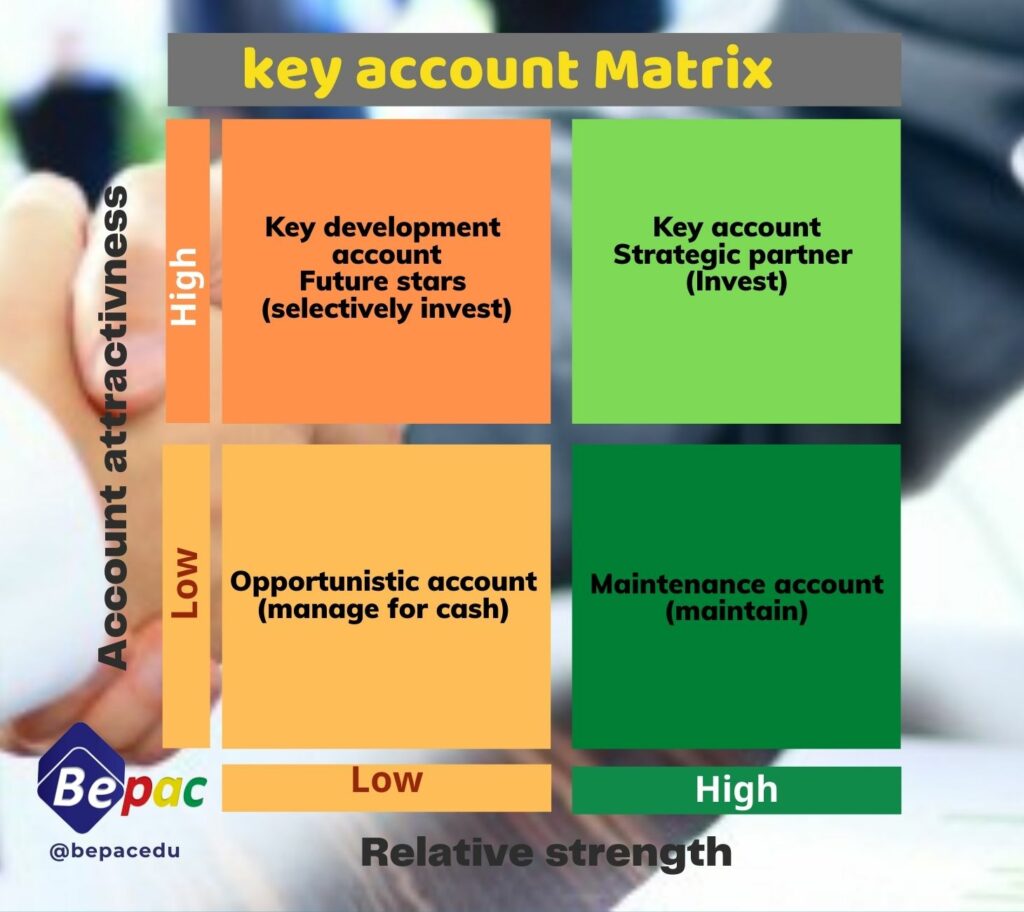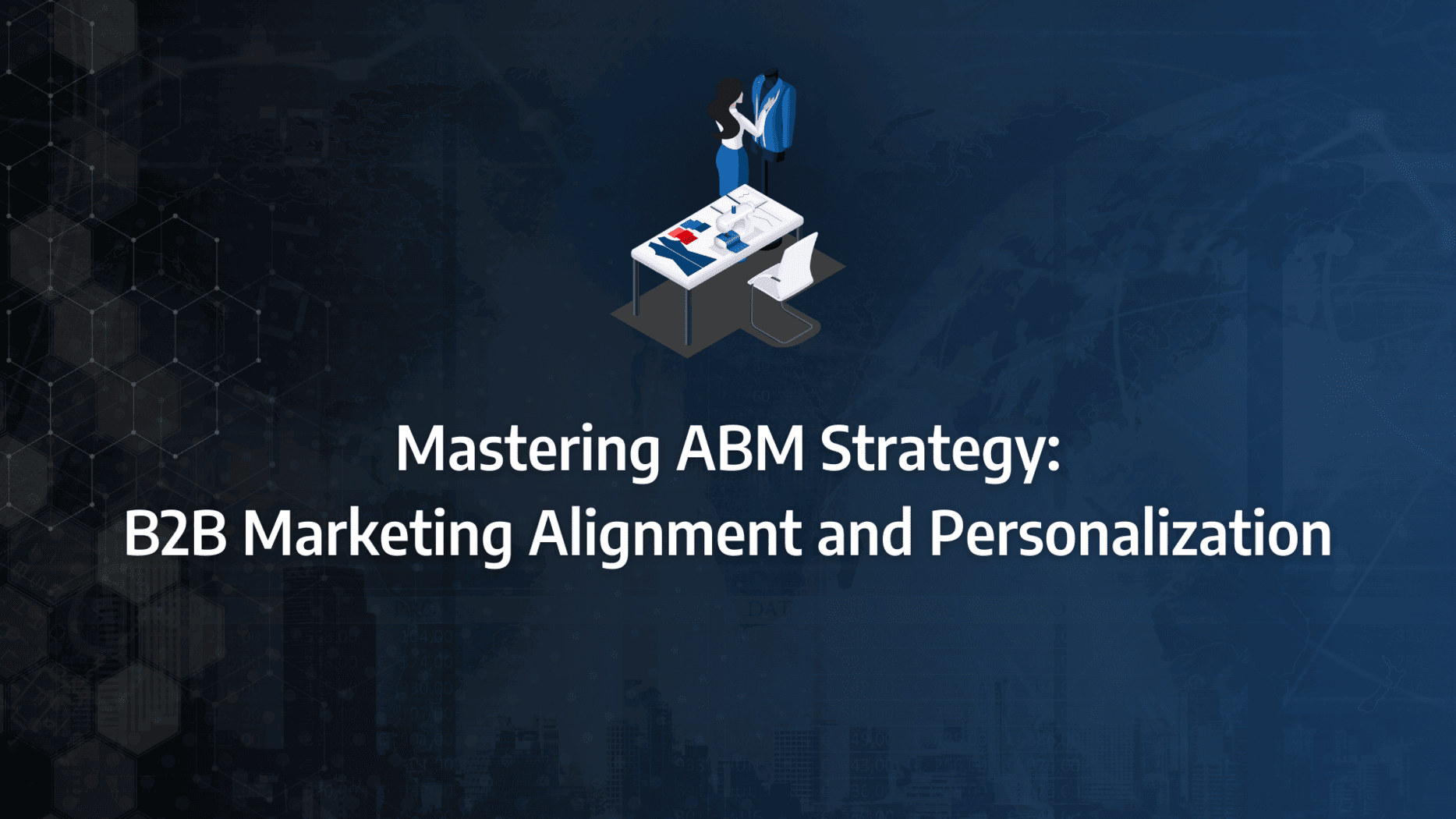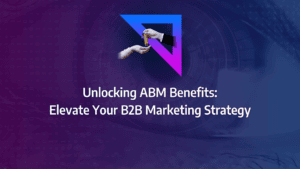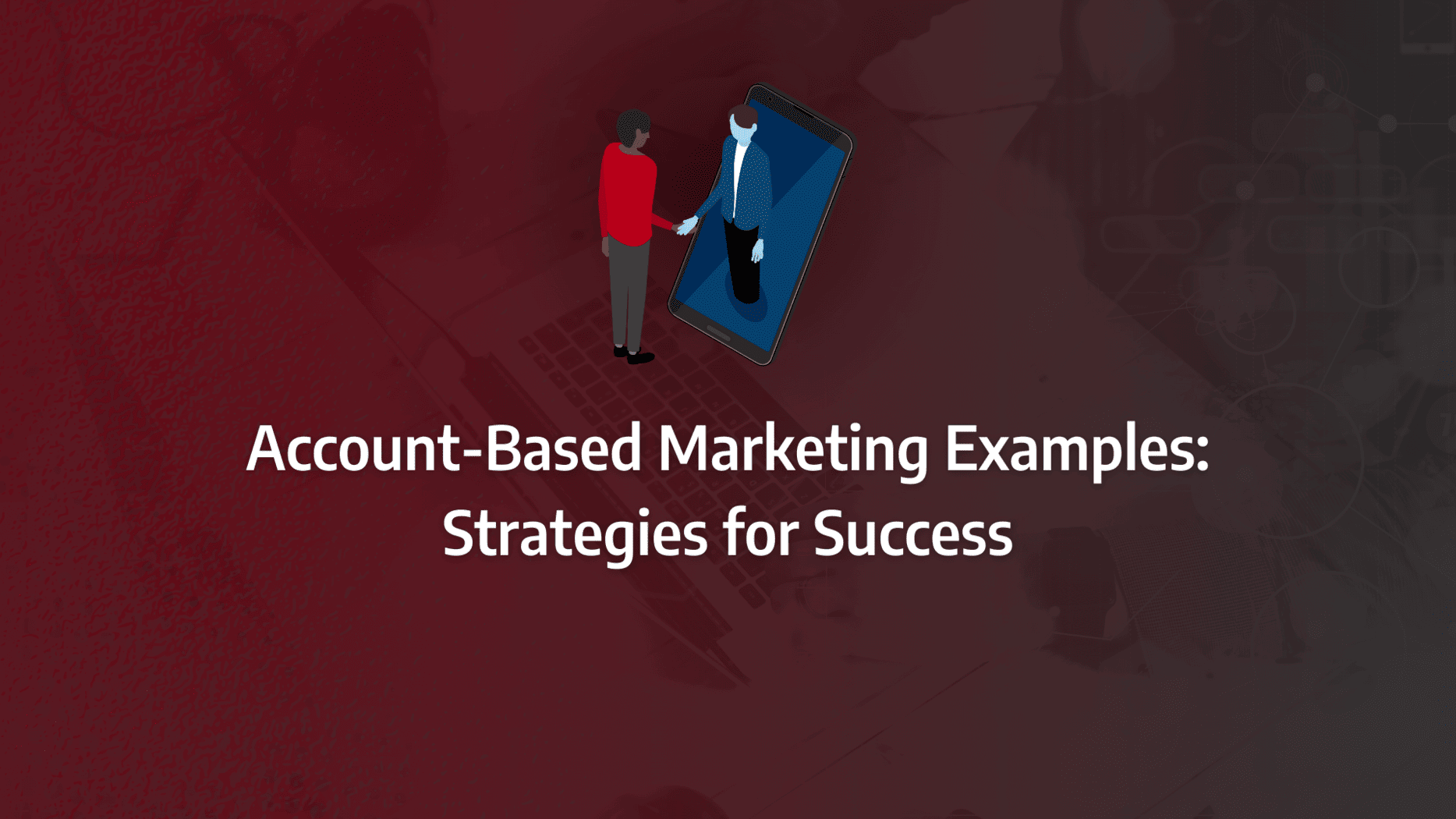Are your marketing efforts spread too thin, failing to deliver the results you need? It’s time to shift your approach. Account-Based Marketing (ABM) offers a solution by aligning your sales and marketing teams to focus on the accounts that matter most.
Embracing ABM strategies can increase in revenue from key accounts and shorter sales cycles. If you’re ready to transform your marketing efforts, this guide will show you how to personalise your ABM strategy, optimise resources, and drive substantial growth from your most valuable accounts.
- Focused Account Targeting: ABM strategies allow B2B marketers to concentrate efforts on high-value accounts, leading to more efficient resource allocation and higher quality leads.
- Sales and Marketing Alignment: Achieving alignment between sales and marketing teams is critical to the success of any ABM strategy, ensuring a unified approach to engaging key accounts.
- Personalised Marketing: Tailoring content and messaging to the specific needs of individual accounts enhances engagement and improves the overall customer experience.
- Increased Revenue Potential: By focusing on the most valuable accounts, businesses can see significant increases in revenue and pipeline velocity.
- Strategic Use of Data: Leveraging data-driven insights helps refine ABM tactics, ensuring campaigns are targeted and effective.
- Scalability of ABM: While often associated with large enterprises, ABM strategies can be scaled to fit businesses of all sizes, offering tailored approaches for diverse customer bases.
What is the Purpose of an ABM Strategy?
Rather than spreading efforts thin over numerous smaller prospects, an ABM strategy focuses on identifying and engaging the most valuable accounts in the market. By employing personalised marketing tactics, ABM strategies effectively entice and nurture these key accounts. A critical component of ABM strategies is the integration of upselling and cross-selling techniques, which maximises the value extracted from each account.
ABM strategies are increasingly pivotal for B2B marketers due to their targeted approach and emphasis on communication with defined segments. By tailoring content specifically for individual accounts, B2B marketers can reap numerous benefits, such as enhanced pipeline velocity and increased business from high-value accounts. The precision of ABM tactics allows marketers to focus on accounts with the highest potential for revenue, thus optimising resource allocation and driving substantial growth.

Is Account-Based Marketing Only for Enterprise Customers?
Contrary to common misconceptions, ABM is not exclusive to enterprise customers. While it is true that enterprise accounts, with their extended lifetime value, are prime targets for ABM, the principles of account-based marketing tactics can be effectively applied to any B2B customer segment. With a bit of creativity, smaller businesses can also leverage ABM strategies. For instance, companies offering highly customised products or services that require repeat purchases can successfully implement ABM tactics to attract and retain smaller clients. By tailoring the marketing approach to meet the unique needs of these businesses, marketers can ensure the successful application of ABM principles across various customer sizes and types.
What Matters Most?
Aligning marketing and sales teams around common goals is critical for successful ABM; clients often find that this collaboration enhances accountability and drives better results. Moreover, having a deep understanding of target accounts enables personalised outreach that resonates effectively, typically leading to improved engagement and conversion rates. Establishing a robust measurement framework with clear KPIs allows organisations to evaluate the effectiveness of their ABM strategies.Get In Touch
What are the key components of an effective ABM strategy?
Step 1: Aligning Sales and Marketing Teams
The alignment of sales and marketing leadership is crucial for implementing an effective ABM strategy. Conflict between these teams often arises from poor communication and inconsistent account management. An automated ABM strategy can significantly improve account segmentation, communication, and management, ensuring a streamlined process.
With ABM automation, businesses can reduce the resources allocated to individual accounts, allowing a focus on territory-level and regional sales activities. It is essential for marketing and sales teams to collaborate closely, brainstorming ABM strategies and systems together. Effective training on ABM objectives and systems, along with regular updates on their long-term value, will enhance team buy-in and lead follow-through.
Step 2: Defining Customer Segments
Utilising the correct ABM tactics can attract ideal leads, making this step crucial for boosting campaign results. When employing account-based marketing, it is vital to create a well-defined framework to segment your audience and database. These segments can then be targeted with specific ABM tactics likely to resonate with potential customers.
Segments can be defined by factors such as:
- Size of the organisation
- Geography
- Company classification
- Annual revenue
- Number of open or closed opportunities
- Current spend
By establishing distinct audience segments, businesses can develop tailored content and messages that appeal to each segment, ensuring effective implementation. Many ABM platforms facilitate this process with automated triggers and filters that respond to account information in real-time, ensuring timely communication with leads.
Step 3: Collaboration
In step three, reviewing and aligning your business’s ideal audiences with your go-to-market strategy is essential. This collaboration helps produce highly targeted sales tactics and messages, increasing the likelihood of ABM success. To prioritise high-value accounts and tasks, pre-programmed follow-ups and alerts are indispensable. Additionally, leveraging marketing automation workflows enhances coordination between customer interactions and sales follow-ups.
Source: IDG
Step 4: Measure Results, Reports, and a 360 Approach to ABM
A robust B2B ABM strategy relies on measurable results to indicate success or failure at the programme, campaign, and territory levels. Many businesses utilise marketing automation to achieve this efficiently. Sharing reports between teams improves collaboration and creates a feedback loop, which may include named account list summaries and activity scoring. This approach ensures that both sales and marketing strategies are focused on the targeted accounts.
Implementing a 360-degree strategy, businesses can provide cohesive messages, align their ABM strategy across teams, track results, and optimise all processes.
Step 5: Host Planning Sessions
A successful ABM implementation requires regular review sessions with sales leaders and managers at the territory level. We recommend hosting sessions every fortnight or month to share, review, and coordinate information and new initiatives. This practice allows businesses to create a clear and consistent experience for target accounts, incorporate new technologies, and address setbacks efficiently. This leads to a sustainable ABM programme that effectively engages decision-makers.
7 Essential ABM Tactics You Need for a Successful B2B ABM Strategy
1. Meet the Needs of the Target Audience Through Content
Content is the cornerstone of any successful ABM strategy. By crafting content that directly addresses the pain points of your target customers, businesses can consistently attract and engage high-value accounts. Utilise various formats such as blogs, videos, webinars, eBooks, and how-to guides to address concerns, answer questions, and meet the expectations of your prospects. Focus on their specific needs and demonstrate how your product or service resolves their particular challenges. High-quality, targeted content significantly outperforms generic messages and posts that merely focus on quantity.
2. Make the Most Out of Data
To maximise the value of your data within your ABM strategy, it’s crucial not to limit its use to just content or reports. Segment and re-utilise this data to more directly target your ideal customers. Identify key data points within your assets and tailor them to fit specific industries, address various maturity levels, and cater to different business sizes. This approach ensures you are getting the most out of your data, enhancing your ability to target and engage effectively.
Source: IDG
3. Leverage Videos
Videos are an excellent medium for communicating with your target customers in a personal and trust-building manner. They can be utilised across various ABM tactics, such as:
- Email and Newsletter Campaigns: High-quality videos in email nurture campaigns can humanise your brand and engage cold leads effectively. Studies indicate that using the word ‘video’ in subject lines can increase open rates by 300%, significantly driving engagement and response rates compared to text-based content alone.
- Screen Share Videos: This method allows you to visually guide target customers through your website, products, and services, addressing pain points and concerns while establishing yourself as an industry expert.
- One-to-One Videos: Personalised videos for individual prospects can make them feel valued and important. Use different personalisation techniques, such as holding up a sign with the prospect’s name in the thumbnail. One-to-one videos provide a deeper engagement level, allowing for a thorough analysis of the prospect’s needs.
4. Separate Customer Testimonials
Customer testimonials are powerful tools for reassuring your target prospects. By segmenting and customising testimonials, businesses can deliver the right testimonial to the right prospect at the right time. Start with keystone testimonials based on the most common uses for your product or service, as these are likely to address a broad range of target customer pain points. For more specific needs, create tailored testimonials that focus on unique pain points for high-value prospects. Encourage current customers to record dynamic video testimonials to complement your content, adding authenticity and credibility to your ABM strategy.
5. Produce a Library of Thought Leadership Content
An essential ABM strategy is the creation of a comprehensive content library. This library should encompass a range of formats, including blog posts, videos, eBooks, and guides. By integrating this content into nurture programmes and various campaigns, you can assure and inform prospects, thereby establishing your business as an industry leader. High-quality thought leadership content not only educates but also builds trust with your target audience, enhancing the overall effectiveness of your ABM tactics.
6. Customisable Video Templates
Sales teams greatly benefit from highly customisable video templates that can be tailored and personalised to meet current needs. These videos are particularly effective for engaging tier one accounts but can also be scaled for use with tier two and three organisations. Customisable video templates enable sales teams to deliver consistent, personalised messages that resonate with high-value prospects, reinforcing your ABM objectives.
7. Send Prospects Personalised Gifts
Sending personalised gifts can significantly strengthen connections with high-value accounts. By thoroughly researching your prospects and understanding their preferences, you can send thoughtful gifts that will enhance trust and appreciation. Personalised gifts are a tangible way to show your commitment to building a strong relationship, which is a crucial component of ABM best practices.
Our Tactical Recommendations
From our experience, implementing multi-channel engagement strategies is essential; clients frequently discover that using a mix of channels creates a cohesive experience that boosts overall effectiveness. Additionally, tailoring content specifically for target accounts is vital for nurturing relationships throughout the buying journey, ensuring communication remains relevant. Lastly, leveraging data analytics to track account engagement enables teams to pivot strategies based on real-time insights, optimising resource allocation and maximising impact in their ABM efforts.Get In Touch
What common mistakes should I avoid in my ABM strategy?
- Not Properly Identifying Target Accounts and Personas: Failing to accurately identify target accounts and personas can severely impact the effectiveness of your ABM strategy. Without a clear understanding of your audience’s interests and needs, particularly those of decision-makers and stakeholders, creating resonant content becomes challenging. An effective ABM strategy requires meticulous tailoring of content to deliver value to the intended recipients. Additionally, content should be localised appropriately; for instance, using British English for a UK audience ensures better engagement. Misidentifying personas can also adversely affect SEO, leading to decreased visibility and less effective content distribution.
- Lack of Personalisation: A lack of personalisation in an SEO-focused ABM strategy can significantly diminish the success of your content. Personalisation ensures that the blog post resonates with the target audience, increasing engagement, views, and conversions. Using appropriate language and localisation is crucial; for instance, employing British English for a UK audience avoids language barriers and misunderstandings, thereby enhancing content effectiveness. Without personalisation and localisation, your ABM strategy is unlikely to achieve its full potential.
- Not Leveraging Relevant Channels and Tactics: Neglecting to leverage the appropriate channels and tactics in an SEO-focused ABM strategy can significantly reduce the effectiveness of your content. Utilising email marketing, social media, display advertising, and search engine optimisation (SEO) are powerful tools for boosting engagement and conversion rates. Failure to exploit these channels can result in missed opportunities for increased engagement and conversions. To drive the desired results, it is essential to identify and utilise the right channels and tactics, ensuring your ABM strategy reaches and resonates with your target audience.









